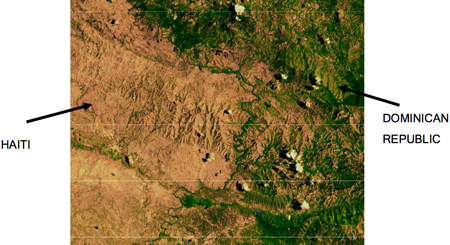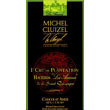FLAVOR PROFILE: somewhat regionally dependent… robust; Earthen (big cocoa, leather), tobacco, & multiple spices; more recently a basketful of fun fruits (from bananas & apricot to guava & granadilla); bold tannins & sparkling acidity; can be astringent & bitter though benefiting from the Dominican Republic’s generally advanced post-harvest practices (fermentation / drying) then further mitigated via careful processing (roast / conching).
CHARACTERISTICS: diverse mix of Amazon (particularly Amelonado, possibly from Martinique), Ecuadorian Nacional, Venezuelan Criollo, plus hybrids like Trinidad’s Trinitarios, Venezuelan Carúpano (Rio Caribe) & a recent rash of ML clones (named Mata Larga where the Dominican Research Institute IDIAF operates); all makes for a chocolate cocktail & source for some of the greatest bars on Earth
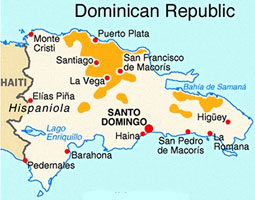
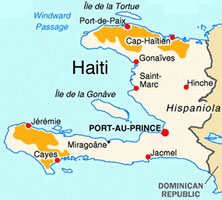 Former home of the Taíno/Arawaks who once spoke what is now known as a ‘ghost language’ because only traces of it remain, such as the loan words ‘tobacco’, ‘hammock’, ‘canoe’, & ‘hurricane’.
Former home of the Taíno/Arawaks who once spoke what is now known as a ‘ghost language’ because only traces of it remain, such as the loan words ‘tobacco’, ‘hammock’, ‘canoe’, & ‘hurricane’.
Site to the oldest European settlement in the Americas (at Santo Domingo), Hispaniola is the sole island visited by Columbus during all 4 of his voyages, including his very first that was lost at sea, charted more on the Bible than on maps & astronomy (sometimes luck is better than science). His diary leaves no doubt that when he finally made shore, it was to “take possession of said land” without asking the residents for their reaction, whom he gravely miscalculated were “fit for to be ordered about & made to work, plant, & do everything else… be taught our customs, & go about clothed”.
In the 200 years after the former corsair Cristobal Colón (his preferred Spanish name) came upon the New World for the accidental ‘gran descubrimiento’ (discovery), only 10% of all Amerindians had survived in the face of ‘God, guns, & germs’, not to mention man-eating dogs. As one missionary said, it was as if the Lord cleared title to all the lands of the continent.
Within the Caribbean the collapse of aboriginal cultures & people was even more precipitous – it took just 50 years – a catastrophe with profound reverberations to this day.
“In the year 1576 a great mortality & pestilence that lasted for more than a year overcame the Amerindians. It was so big that it ruined & destroyed almost the entire land. The place we know as New Spain was left almost empty.” — Friar Juan de Torquemada
Just at the time prized cacáo forests in the New World underwent their own kind of attack at the hands of demographic shifts, overproduction, & a raft of decimating diseases from ‘witches broom’, ‘pod rot’, & ‘blast’ that nearly wiped it out, back in Europe demand for chocolate skyrocketed, attending the rise of the consumer class whose expanding appetite for all luxuries novel & exotic – adding up to shopping for tropical groceries & the forbidden tastes of paradise – ignited the chocolate phenomenon into a massive explosion.
In response, colonial settlers switched to cultivating heartier, more resistant strains pulled from accessible parts of the Amazon, typically of bitter flavor, requiring ever greater amounts of sugar (also harvested in the New World) to make it palatable. Pulling this off required workers to perform back-breaking labor.
Europeans viewed Amerindians thru a veil interwoven with romance & prejudice, seeing pre-literates as brutal savages inhabiting a post-lapsarian eco-Eden – truth was probably neither or maybe a mix of both – which simultaneously idealized them & justified their extinction. Similar to our times, pre-Columbian life in reality was filled with the inequality & power struggles of a complex society.
The few Amerindian communities to escape total extinction resisted or refused, understandably, to be subjugated into working the mines, or impressed on lands growing & harvesting cash crops on the Spaniards’ harsh forced-labor terms called encomienda. Equally bad, they were prevented from tending to crops vital for survival & their own sustenance – a ‘lose-lose’ situation. In their eyes, why should they become slaves to their own wealth?
To the original Americans, who lived in a kind of pre-profit capitalism, the European appetite was absurd, always hungering for more & more even to the point of bequeathing wealth from the grave, encapsulated in this Tupi from Brazil explaining – ‘You Frenchmen are great madmen. You cross the sea & suffer enormous inconvenience… & work so hard to accumulate stuff for your children & those who survive you. Is the land that nourished you not sufficient to feed them too? We have fathers, mothers, & children whom we love. But we are certain that after our death the land that nourished us will also feed them. We therefore rest without further cares.’ Apparently the Frenchman & his rather feudal European cohorts failed to see that the people they were trying to subordinate already belonged to Veblen’s leisure class in an environmentally-advanced society well before any need for a ‘green revolution’. For his part the Tupi failed to grasp the undying zeal & appetite of Frenchmen whose confrère – John de la Roque – sailed all the way around the horn of Africa instead of taking the shorter & quicker overland route to Mocca Yemen for a cup of coffee in 1708 because it dramatically cut shipping costs – even though he was at sea for two & half years!
Faced with this dynamic, the arrived-at solution compounded the crime, turning uglier still: the Middle Passage, a grisly triangle uniting African Kingship, Arab traders, & European shipping. Upwards of 12.5 million were branded, prodded & herded, as chattel like cattle, into ships on voyages to the maafa (Swahili for ‘disaster’) where, in the words of writer Jorge Amado, the fields are fertilized in blood.
That’s if they survived the journey.
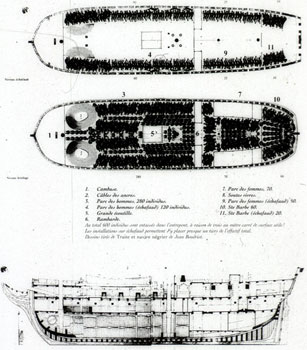
The Slave Ship by Marcus Rediker recounts first-hand experiences of sailor-turned-abolitionist James Field Stanfield & Olaudah Equiano (whose Igbo origins may be in dispute but not his status as a slave ship griot). Both tell of hell on the high seas – 20% perished en route, known in the business parlance as “leakage”, while another 50% would die within 3 years into their frightfully short “career”, making for survival odds only marginally better than Soviet gulags – where jumping ship knowingly meant sure death for people who could not even swim. “When we found ourselves at last taken away, death was more preferable than life”. In a harrowing tale during the winter of 1781, owners of the sailing vessel Zong audaciously filed an insurance claim for ‘lost cargo’, invoking the ‘jettison clause’ that pertains to horses or wood, after 122 slaves were thrown overboard due to overcrowding, malnutrition & disease (all common occurrences); another 10 jumped off in despair. That such a fate was nonetheless a welcome escape to freedom is the very embodiment of Patrick Henry’s ‘give me liberty or give me death’. True Americans all.
The devil’s bargain struck & stuck however, & today the original Grand Cacáo is all but gone while the human dimensions can still be felt. Hispaniola received the first African slaves in 1501. Haiti/Ayiti, a nation of African descendents & formerly the largest slave labor force in the world, is the poorest in the Western hemisphere. A sad backwater in light of its once being crowned the “Pearl of the Antilles” – the richest colony in all the Caribbean & proud home to the only successful slave revolt ever which, alas, soon factionalized into a kleptocracy. It ranks at or near the top in all the wrong places: extreme poverty, high infant mortality, & embarrassing illiteracy. In short, a disaster zone… some of it of their own lassitude; the rest of it the burden of history & centuries of internal strife as well as external pressure leading to political / civil unrest. Plus natural catastrophes have left their mark too (4 hurricanes in less than a month during 2008; earthquake devastation in 2010 – a crisis however that could lay the groundwork to press the re-set button… to transcend their past & begin anew as a nation in solidarity, even as MacArthur Fellow Mark Danner cautions that they walk in history, live in corrupt predatory politics… distinct, apart, & singular in a kind of ‘Haitian exceptionalism’… virtually beyond outside & often misguided help).
Whatever its direction, graffiti in the streets of Port-au-Prince sends the undeniable message in Creole: Retou ala Vi. Ayiti Pap Peri (Back to life, Haiti won’t die).
Once sugar & its rum by-product sweetened her to a rotten shame, Haiti turned into a slave prison fronting as a sugar plantation. And the two together – sugar + slavery – equaled money that converted to power for those in control. In their book, The World that Trade Created, Kenneth Pomeranz & Steven Topik share a conviction in declaring Haiti both a slave colony & the original modern factory. Plantations with a division of work crews organized into specialized labor, efficiently converting raw cane, thru large scale machinery, to manufacture refined sugar on an industrialized clock. Eric Williams, the first Prime Minister of neighboring Trinidad-Tobago, also a sugar-cocoa colony, seconds the notion: “No sugar, no Negro”.
The same can be said of chocolate too which in the Mayan / Mesoamerican world literally constituted an original cold ‘cash-crop’ (a 16th-century report by Francisco Hernandez on the plants of Mexico lists 4 kinds of cacáo… three preferred for money [quauhcacahoatl for ‘big’; mecacacahoatl or ‘medium’; xochicacahoatl – ‘small’ & red], the fourth for drinking [tlalcacahoatl / smaller]) is now an even bigger, more impersonal business commodity.
Despite all the happy-talk of “money that grew on trees”, Vanderbilt anthropologist William Fowler documents that its use as money in Mesoamerica was connected with native imperialism: long-distance trade & marketplace exchange at the bidding of the Emperor who consolidated both political & religious power, in the quest for the developments of state, urbanism, & social strata rife with severe inequalities of land tenure & production that saw elites controlling labor & exacting tributes in the form of cacáo payments from the underclass.
A line can be drawn from both Adam Smith & Karl Marx down to contemporary economists connecting the companies & profits from the slave trade & slave-based markets — fueled by cravings for far-off tropical goods like sugar & coffee whose methylxanthine caffeine along with nicotine from tobacco are all prime motors to the agitated pace of modern life — as a precursor if not a propulsion to the Industrial Revolution. The Equation: (cheap land in the New World) x (cheap labor from Africa) = gold + silver -> exchanged for Asian silks, spices, & tea as well as additional slaves. When European appetites for cocoa, sugar, tobacco, & tea exhaust much of the wealth, draining gold / silver, & start running up deficits from the New World enterprise lost in wars of independence led by generals George Washington, Toussaint-Louverture, & Simón Bolívar, the empire quest shifts to regions that are home to strict autocrats & customs (e.g., India) which it colonizes & where it concocts a cheap but potent blend of opium (the crack cocaine of its day) to hook China as payback for hooking England on tea which pays for more tea, silks, & spices… & the cycle repeats in a continual loop. In this sordid McWorld, a proportionately small but significantly prejudiced lot of Africans have done the dirty work even to the extent that radicals bent on ‘fight the power’ use them for fodder, the hired guns in the rap of activist Ishmael Reed – “nigger pull the trigger”.
An oversimplification & surely reductionist but, like clichés, with a measure of truth.
And in an acute irony, Africans are thought to have hastened the extinction of the very Amerinds which they were enslaved to replace by introducing smallpox, thus condemning millions more of their own brethren to a miserable existence. The precise circumstances remain uncertain as to who brought smallpox over from the Old World, or even exactly where it first landed in the New World — possibly Hispanioala in 1518, followed by Cuba a year later. But the first case reported by Bernal Diaz del Castillo, an eyewitness to Hernán Cortés’ conquest of the Mexìcâ / Aztecs on the American mainland, implicates a man — Francisco de Eguía — of African heritage who arrived from Cuba on the east coast of modern day Mexico during Tepeilhuitl (a Mexica festival month corresponding to late October):
Narváez (Pánfilo de Narváez) brought with him a Negro who had small pox; an unfortunate importation into that country, for the disease spread with inconceivable speed, & the Indians died by the thousands; for not knowing the nature of it, they raised it to a fatal point by throwing themselves in cold water in the heat of the disorder.
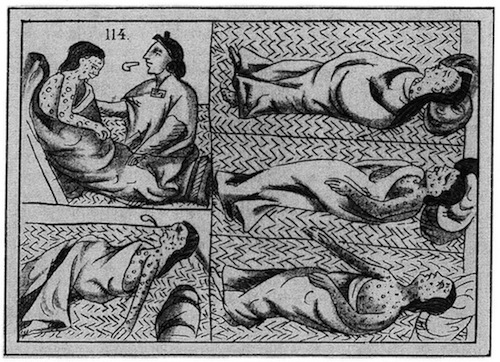 Contemporaneous depiction of Mesoamericans suffering from smallpox (Florentine Codex, Volume 4, Book 12, Plate 114)
Contemporaneous depiction of Mesoamericans suffering from smallpox (Florentine Codex, Volume 4, Book 12, Plate 114)
Even more cruelty would complete the viscious irony. In 1772, to illustrate but one bitter harvest, some of the very cacáo picked by black slave hands in the Caribbean was eventually manufactured into 200 pounds of chocolate along the Lower James River in Colonial Virginia by other African slaves. That chocolate was then shipped across the Atlantic to West Africa to barter for more of their brethren who were summarily enslaved with it. The cycle repeated itself ad nauseum.
Into this bleak reality would shine but few lights such as L’An 2440, rêve s’il en fut jamais (literally, “The Year 2440, A Dream If Ever There Was One”; English title Memoirs of the Year Two Thousand Five Hundred), a moralizing guidebook to the future penned in 1771 by Louis-Sébastien Mercier. Within its pages, Mercier leveled this indictment at his fellow citizens: “It may be very agreeable to sip chocolate, to breathe the scent of spices, sugar, pineapples & rum… But are these sensations sufficiently voluptuous to close our eyes against the crowd of unheard of evils that such luxury engenders in the 2 hemispheres?”
**********************
There are some modern success stories to emerge from this generalized disgrace, though far too few. While Fair-Trade, Equitrade, Direct Trade are gamed by many, they at least represent an opening toward reconciliation & building social bridges to a new future to turn tragedy into history – if… we can ever truly get on the other side of it.
For further discussion on what can be done, see Bar-to-Bean™ consumer-activism.
Back on the ground… Hispaniola divides between impoverished Haiti & relatively prosperous Dominican Republic. They share the same island but live worlds apart. The border between them demarcates sharply along lush green forests in the Eastern Dominican side & bare brown mountains to the Haitian West. The latter the result of severe environmental degradation where any tree stands little chance of survival, let alone thriving for export markets, at the hands of people too poor to afford much of anything… but to chop them down for cooking fuel & home heating. What meager cocoa it brings to market has had a reputation for moldy, larva-infested beans.
Over in the D.R., which has recently vaulted into a major producer for global export thanks to 40,000 growers, the island cultivates a diverse cacáo population, including the largest amount of organic cocoa in the world. Centered around Duarte Province as well as the country’s northeast, The Dominican Republic developed its organic cacáo sector in the 1980′s.
The entire island markets 2 broad types: Hispaniola (fermented) & Sanchez (unfermented). The latter makes up about 70% of the annual Dominican cocoa export.
Specific genotypes in the mix run from Amazon (particularly Amelonado, ferried in possibly from Martinique), Ecuadorian Nacional germplasm (of the EET Series) Venezuelan Criollo (among them an estate started by Swiss maker Philipp Suchard & another of strong Criollo presence brought from the Lake Maracaibo area in the early 20th century that stands in a rather pure form even with ongoing genetic erosion & breeding programs) to hybrids like Trinidad’s Trinitarios (including TSH + ICS) & Venezuelan Carúpano (Rio Caribe). Add Jamaica too. Since 2006 the local Dominican Research Institute IDIAF has busily bred & grafted the ML hybrids, so christened after the village where it operates — Mata Larga.
This all makes for a chocolate cocktail & source for some of the greatest bars on Earth.
